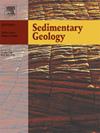Fine-grained sediments down-sagging into coarse-grained substrate: A new category of soft-sediment deformation structures and their paleoseismological implications
IF 2.9
2区 地球科学
Q1 GEOLOGY
引用次数: 0
Abstract
This study investigates a novel type of soft-sediment deformation structures (SSDS), here termed “down-sagging sediments”, characterized by the downward penetration of less dense sediments into denser sediments. This type of SSDS was identified within fluvial sedimentary successions excavated at the epicentral region of the 2017 Pohang Earthquake and two trench sites (Inbo and Yanggok) in the Korean Peninsula. This study investigated the donw sagging sediments to unravel the morphological characteristics and forming-processes together with their potential as paleoseismological indicators. Down-sagging sediments developed along boundaries between overlying sandy mud and underlying sand (Pohang and Yanggok) or overlying mud and underlying sandy mud (Inbo). These down-sagging sediments show two main varieties: (1) vertically connected bodies maintaining physical continuity with overlying fine-grained sediments and (2) detached fine-grained bodies enveloped by underlying sand or sandy mud. Vertically connected bodies formed through the passive downward penetration of overlying less dense mud into void space created by upward expelled sediments via fluidization. Subsequent disintegration of the vertically connected down-sagging mud by fluidized sediments is responsible for the formation of the detached down-sagging sediments. Although the present study interpreted these structures to have been formed by seismic shaking, they can potentially form at any sediment interface where fluidization is the dominant deformation mechanism. Nevertheless, at the epicentral region of the 2017 Pohang Earthquake where >600 sand blows formed on alluvial plains following the earthquake, the systematic vertical zonation–progressing from upper connected down-sagging sediments with detached ones having highly irregular margins to lower detached down-sagging sediments with smooth margins–may have been formed by two sequential processes: 1) down-sagging and subsequent disintegration during the mainshock, followed by 2) frictional abrasion of the disintegrated down-sagging sediments within underlying re-liquefied sand possibly as a result of forward and backward motions during aftershocks. This sequential development pattern may represent seismic events characterized by mainshock followed by aftershocks, suggesting their potential utility as paleoseismological indicators.
细粒沉积下塌成粗粒基底:一类新的软沉积变形构造及其古地震意义
本研究研究了一种新型的软沉积变形构造(SSDS),这里称为“下下垂沉积物”,其特征是较低密度的沉积物向下渗透到较致密的沉积物中。在2017年浦项地震震中地区和朝鲜半岛的两个海沟遗址(仁宝和杨谷)挖掘的河流沉积序列中发现了这种类型的SSDS。通过对下塌沉积物的研究,揭示其形态特征、形成过程及其作为古地震指示物的潜力。沿上覆砂泥和下覆砂(浦项和杨谷)或上覆砂泥和下覆砂泥(仁川)的界线发育下沉降沉积。这些向下下垂的沉积物主要表现为两种类型:(1)与上覆细粒沉积物保持物理连续性的垂直连接体;(2)被下伏砂或砂质泥包裹的分离细粒体。垂直连接的体是由上覆较低密度的泥浆被动向下渗透到由流化向上排出的沉积物形成的空隙中形成的。流态化沉积物对垂直连接的下沉降泥浆的后续崩解是分离下沉降沉积物的形成原因。虽然目前的研究解释这些结构是由地震震动形成的,但它们可能在流化是主要变形机制的任何沉积物界面上形成。然而,在2017年浦项地震震源区,地震后冲积平原上形成了600次吹沙,从边缘高度不规则的上部连通的下凹陷沉积物到边缘光滑的下部分离的下凹陷沉积物的系统垂直带可能是由两个顺序过程形成的:(1)主震期间的下塌和随后的崩解;(2)下伏再液化砂中崩解的下塌沉积物可能由于余震期间的前后运动而发生摩擦磨损。这种序列发展模式可能代表了主震后余震的地震事件特征,表明它们作为古地震学指标的潜在效用。
本文章由计算机程序翻译,如有差异,请以英文原文为准。
求助全文
约1分钟内获得全文
求助全文
来源期刊

Sedimentary Geology
地学-地质学
CiteScore
5.10
自引率
7.10%
发文量
133
审稿时长
32 days
期刊介绍:
Sedimentary Geology is a journal that rapidly publishes high quality, original research and review papers that cover all aspects of sediments and sedimentary rocks at all spatial and temporal scales. Submitted papers must make a significant contribution to the field of study and must place the research in a broad context, so that it is of interest to the diverse, international readership of the journal. Papers that are largely descriptive in nature, of limited scope or local geographical significance, or based on limited data will not be considered for publication.
 求助内容:
求助内容: 应助结果提醒方式:
应助结果提醒方式:


